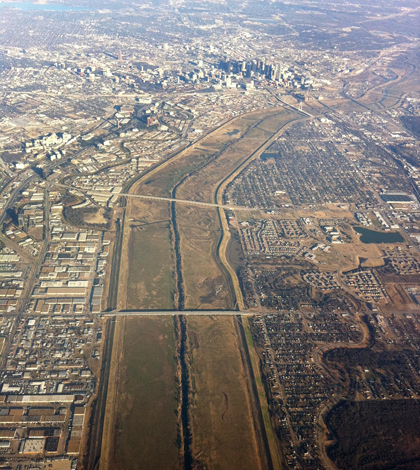Study of Texas’ Trinity River shows 40 years of improved water quality and fish diversity

The Trinity River near Dallas (Credit: Glenn Harper/CC BY-SA 2.0)
Texas’ Trinity River is in much better shape than it was a century ago, according to a recent study of decades of fish and water quality data.
That’s good news for this river, which flows from the Dallas-Fort Worth area to the Gulf of Mexico and supplies the greater Houston area with drinking water along the way. Prior to cleanup initiatives launched in the ’70s, it has been degraded “as long as we could tell,” according to Joshua Perkin, the study’s lead author.
“The Texas Department of Health in 1925 described the Trinity River as a ‘mythological river of death,'” Perkin said. “And these people work for the health department, so they don’t have a sense of humor.”
Even records going back to the 1880s described the river as “unfavorable to fish life,” said Perkin, who studied and taught in Texas before taking his current position as an assistant professor in the Tennessee Technological University’s biology department.
Those hyperbolic qualitative descriptions are helpful, but much more useful for scientific purposes are the water quality data the U.S. Geological Survey began collecting along the river in 1968. The researchers also had fish data from multiple sources covering the same timespan, which happens to being around the same time governments began passing legislation to clean up rivers, both nationally and specifically for the Trinity River.
An analysis of those data shows that ammonia, phosphorous and biological oxygen demand all decreased in the Trinity River following cleanup efforts in Dallas-Fort Worth. In the meantime, fish communities also bounced back, as native and sensitive species returned to the river.
“We’ve seen a dramatic change and a pretty strong improvement since what it was 40 years ago,” Perkin said.

The Trinity River saw the greatest improvement near the Dallas-Fort Worth area (Credit: James Adamson/CC BY-ND 2.0)
The results show that between 1969 and the mid 1980s, ammonia concentrations declined from well above to well below the level deemed acceptable by the Texas Commission on Environmental Quality. At the same time, nitrate concentrations actually increased. That’s likely the result of growing secondary wastewater treatment efforts in Dallas-Fort Worth that processed ammonia into nitrate, Perkin said. So even though nitrate levels climbed, there was less ammonia, which can be toxic to fish and lead to increased biological oxygen demand.
The fish communities saw what Perkin called a “fantastic transformation.” The greatest improvement in the reach directly downstream of Dallas, where sampling by the Texas Parks and Wildlife Department in the ’70s would occasionally turn up no fish at all. Since then, the number of native and sensitive species has increased dramatically, including the return of bullhead minnows, blackstripe topminnows and game fish like blue catfish to areas where they had disappeared. Perkins hypothesized that, during the bad years, many of those species persisted in less-degraded tributaries of the Trinity.
“As the water quality in the main Trinity River improved, those fish that were waiting in the wings of the tributaries moved back in.”
Perkin said the study, published in the journal River Research and Applications, is a rare example of well documented improvements in a waterbody following the Clean Water Act and similar legislation. It’s not that many people dispute the benefits of those laws, but it has been difficult to quantify the long-term recoveries in specific rivers because very few of them had the data-logging infrastructure in place to keep track of those changes.
“We got kind of lucky that the USGS was watching what was going in terms of water quality.”
Top image: The Trinity River near Dallas (Credit: Glenn Harper/CC BY-SA 2.0)




0 comments